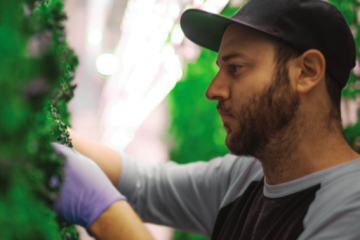Feeding the future
This "could be massive,” said Galen G. Weston at a conference on the future of food in Toronto in May. The Loblaw chief wasn’t referring to the grocer’s new President’s Choice Cricket Powder (although he talked about that, too). Weston was speaking about the potential of vertical farming; specifically, the potential of such farms to help the planet while also addressing food insecurity in Canada’s North, where it’s difficult and expensive to transport fresh food.
Through its PC Children’s Charity, the grocer recently donated a vertical farm to a high school in northern Saskatchewan. Modular Farms Co. is the Ontario-based company that developed the farm for Loblaw. Its purpose-built farms, which look like shipping containers, are designed for any climate and can yield, for example, up to 1,000 heads of lettuce a week using 95% less water than a typical field farm and no pesticides. Along with food retailers, the company has piqued the interest of the Canadian military and Google’s Sidewalk Labs.
We chatted with Aaron Spiro, president of Modular Farms Co., (pictured) about the slow but steady adoption of vertical farming and why this new form of agriculture is a smart solution for grocers big and small.
We hear a lot of buzz around vertical farming. Do you think this is an idea that’s time has finally come?
Yes. The industry has dragged along for many years, mainly because of the high operational costs, but costs have come down and it’s never been as economically viable as it is today. LED
What benefits can grocers reap from adding a vertical farm to their operation?
Not everyone, especially smaller grocery chains, can have their own brand of food to sell through their stores—this gives them that ability. The farms are also small so they can be put directly at distribution centres or at grocery stores themselves. Usually a couple of farms on site can provide enough leafy greens or herbs to satisfy the needs of the entire store. For larger stores the farms can be placed at distribution centres/warehouses where grocers can grow their own food, put it on a pallet and send it out to their stores. It gives them a huge advantage of cutting a lot of their transportation costs related to importing food from places farther a field and then, obviously, the environmental impact is huge in terms of cutting down the transportation miles and carbon footprint. And grocers can guarantee their customers the freshest produce they can get their hands on. It also helps show they’re taking a step towards making their business more sustainable and that they care a lot about the quality and the transparency of the food that’s being sold in their stores.
So greater self-sufficiency is also part of the appeal of these farms?
For sure. The more grocers—large and small—that adopt vertical farming technology, the more we free ourselves from relying on other countries for food.
What can be grown in a vertical farm?
Technically you can grow almost anything in the towers within the units. We’ve grown everything from corn to peppers and quinoa, mini pumpkins and cucumbers—it all depends on what you’re using the container farm for. The majority of our customers are using the farm as a business and they want to generate a decent return on their investment; growing things like kale and herbs and lettuce usually gives you the highest return in terms of what you can grow the easiest with the least amount of labour. But then again, you can grow things like strawberries, raspberries and cherry tomatoes, no problem; they have high yields, there’s just a lot more labour involved. We’re also continuing to experiment with lots of different crops and we’re continually amazed by what we’re actually able to grow vertically—so the sky’s the limit, really, in terms of what we can actually grow.
Your company has expanded quickly in the past few years. What’s next?
We’re working on finalizing and commercializing our next set of


